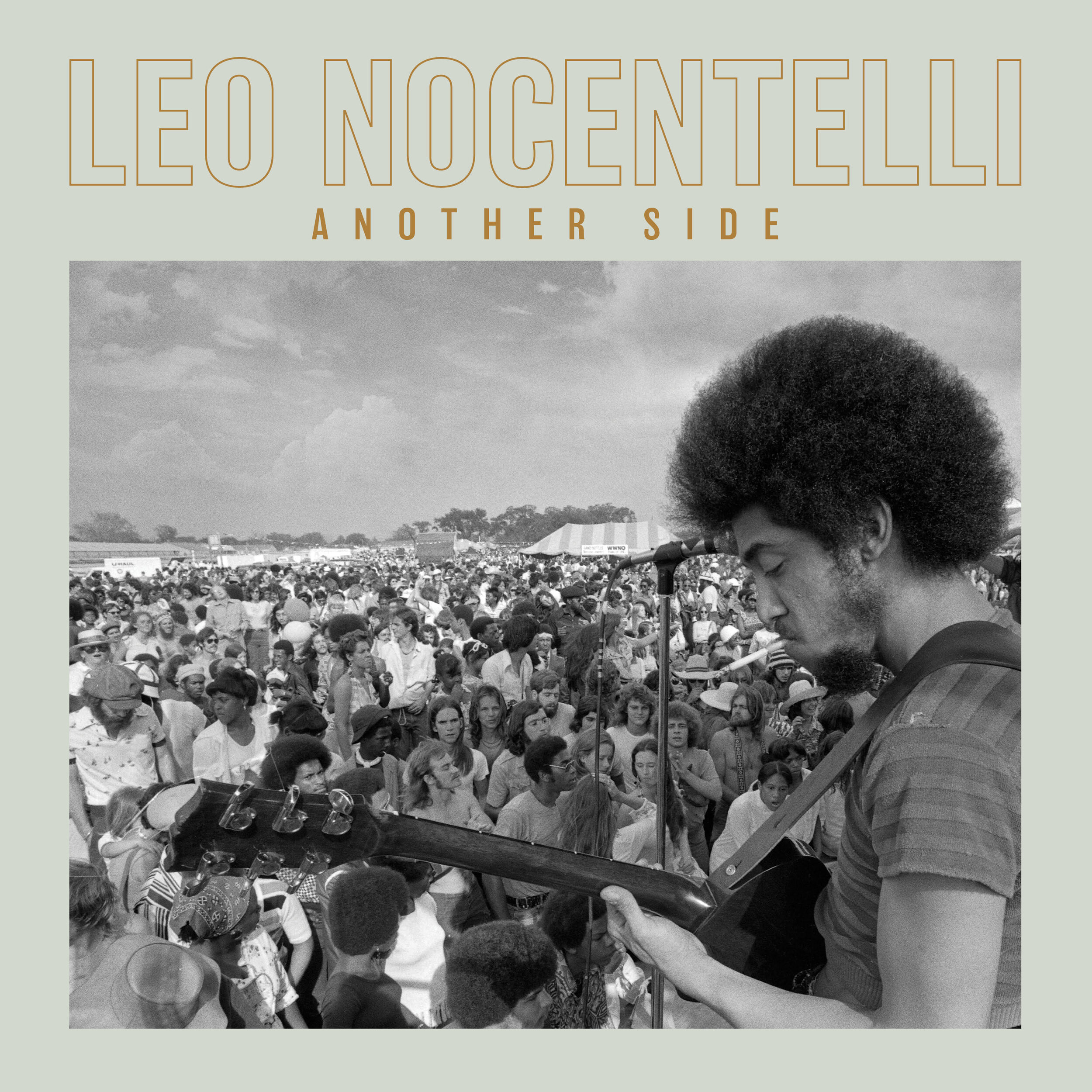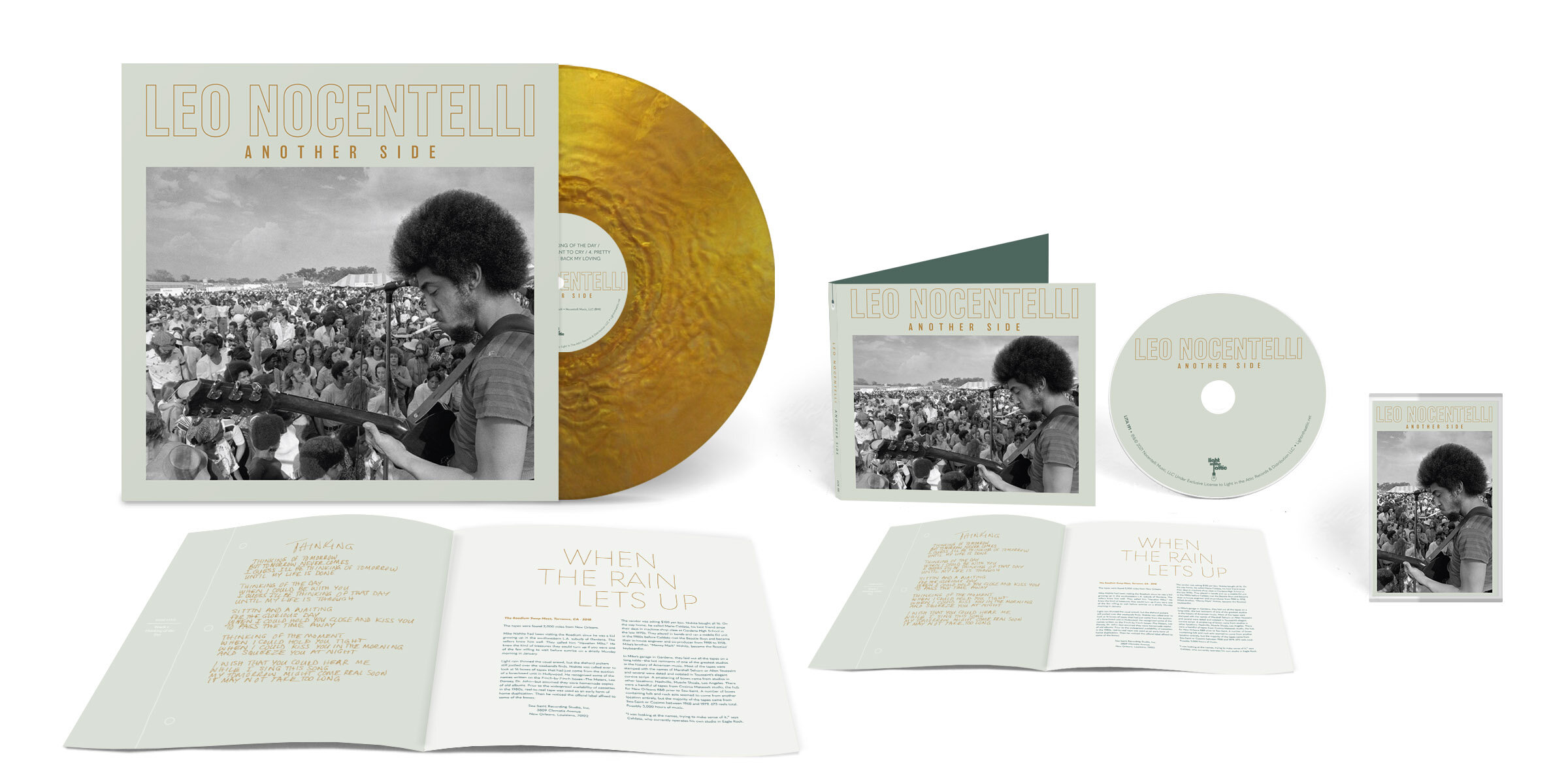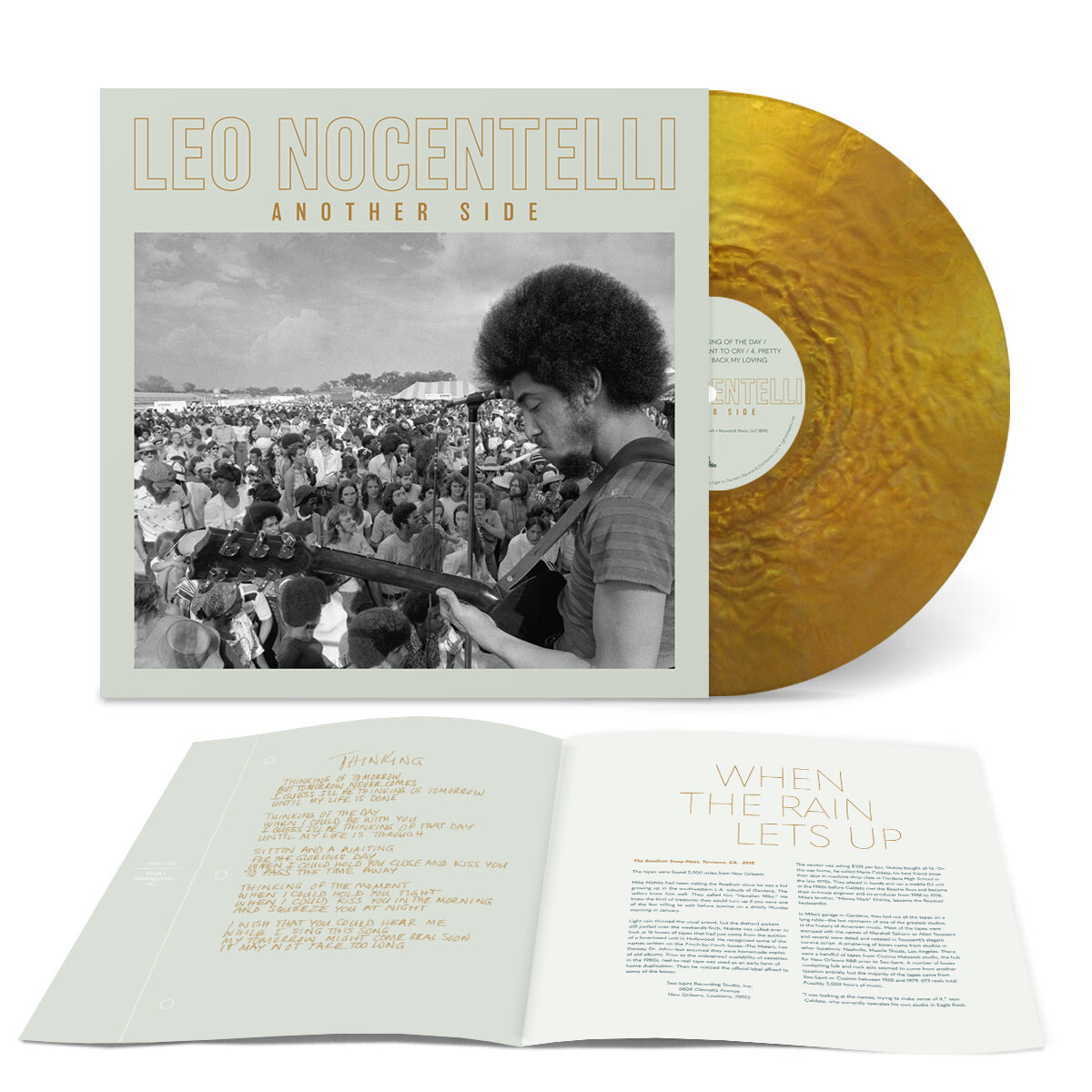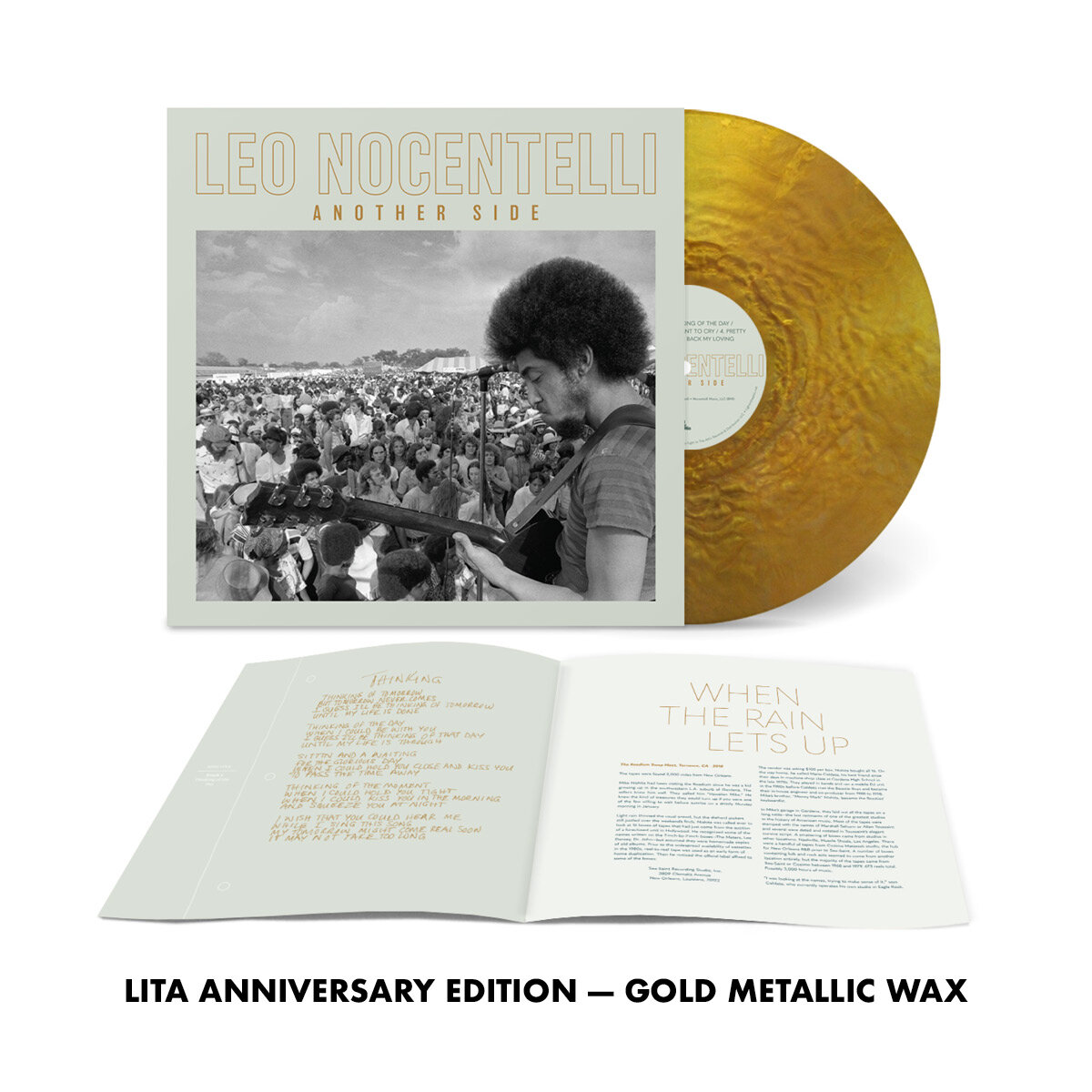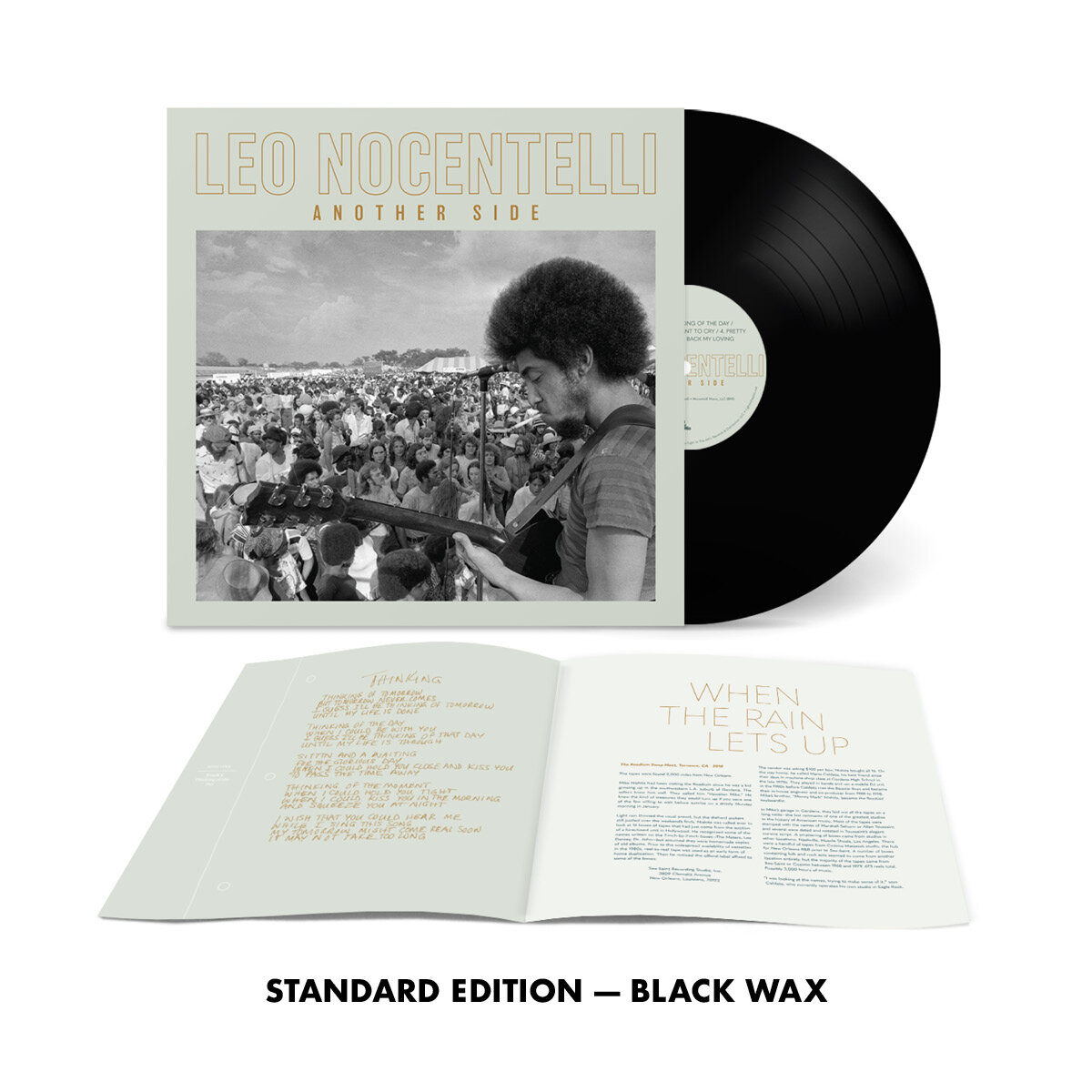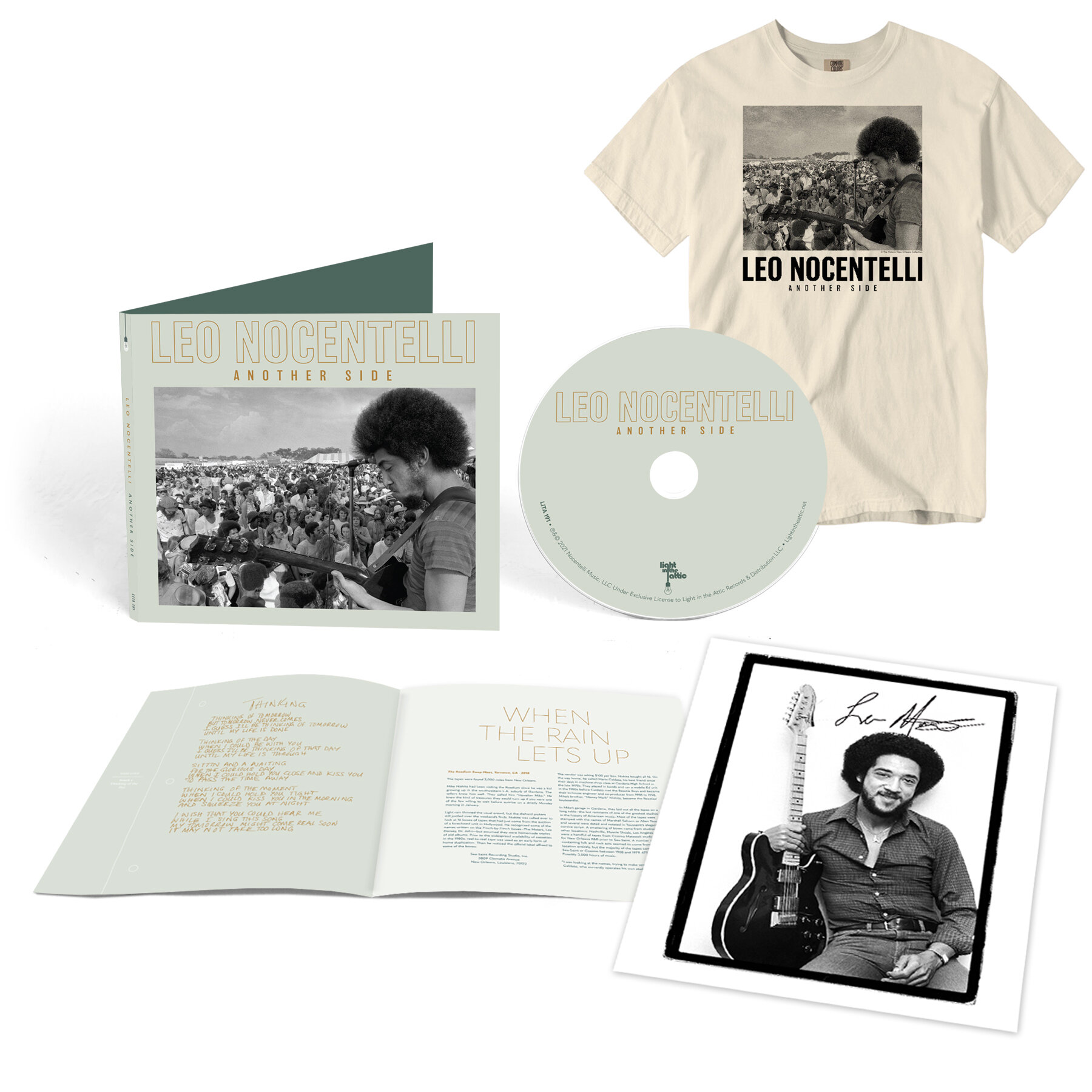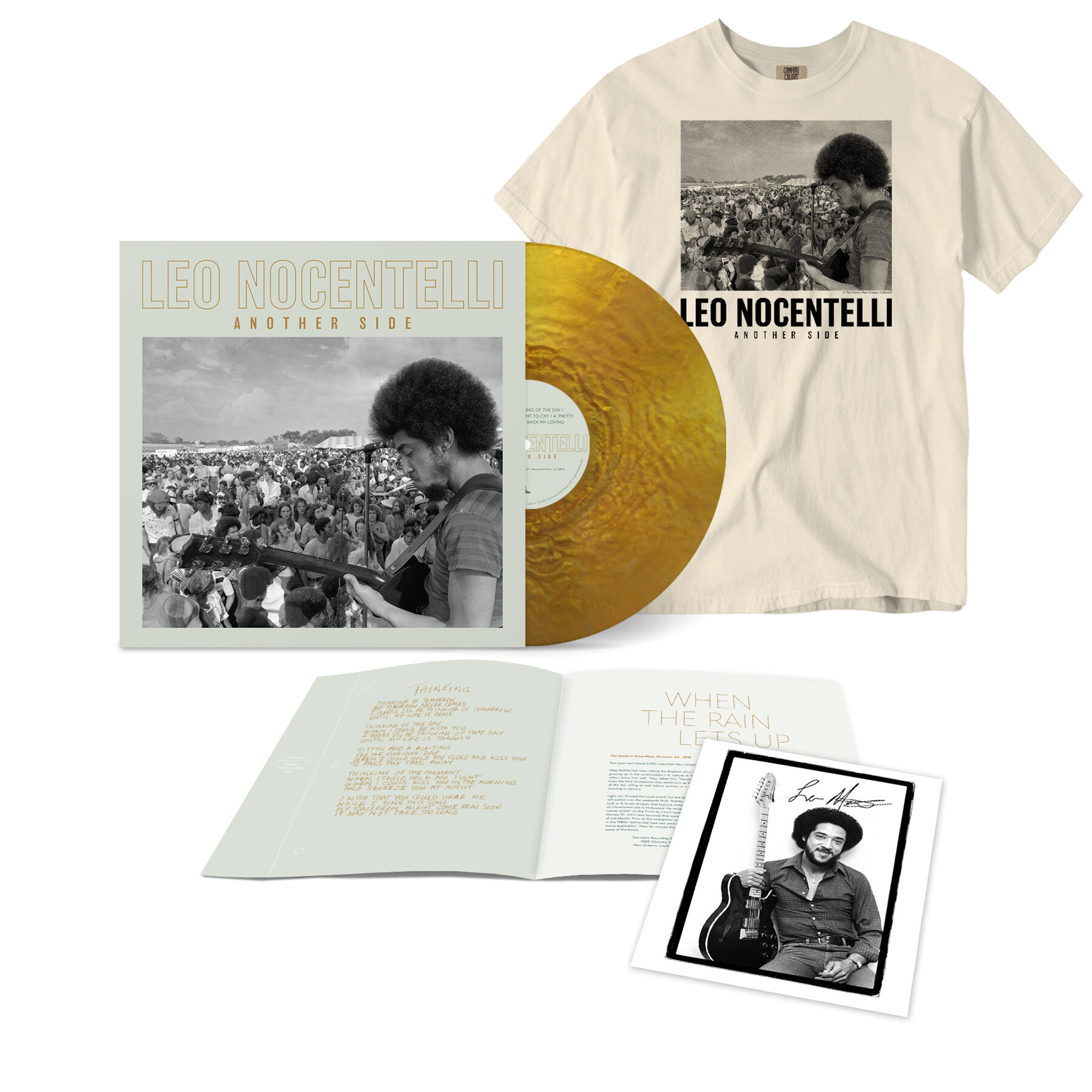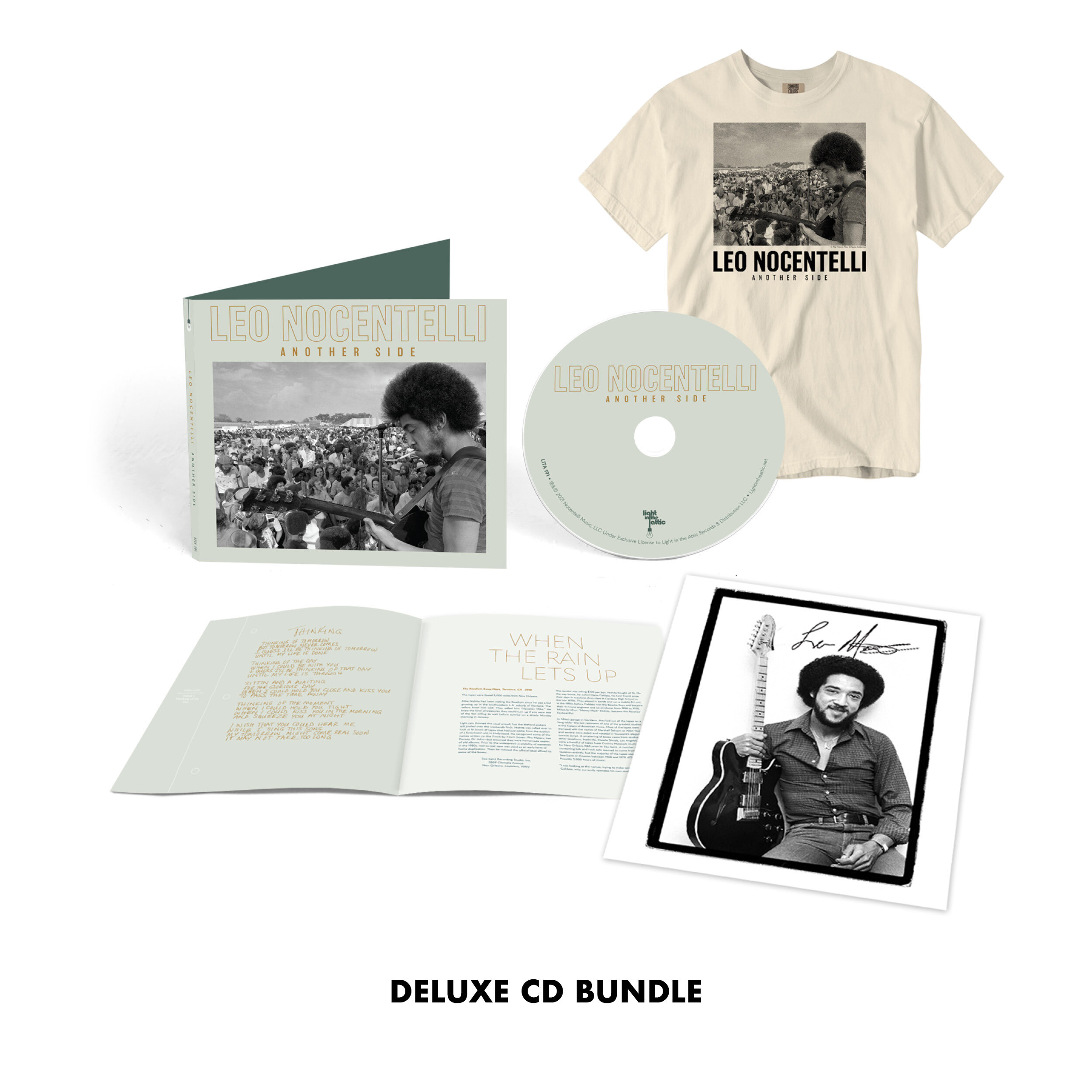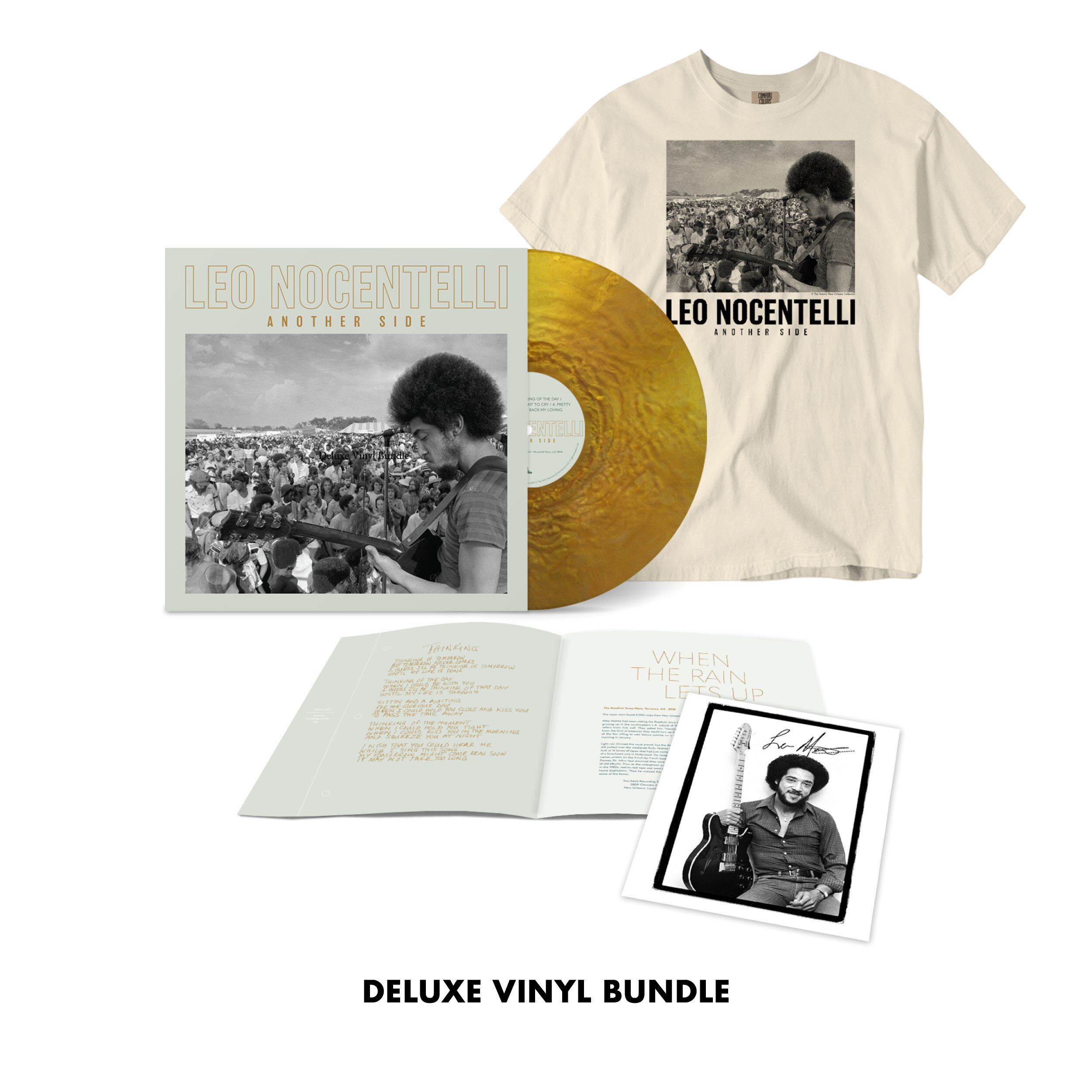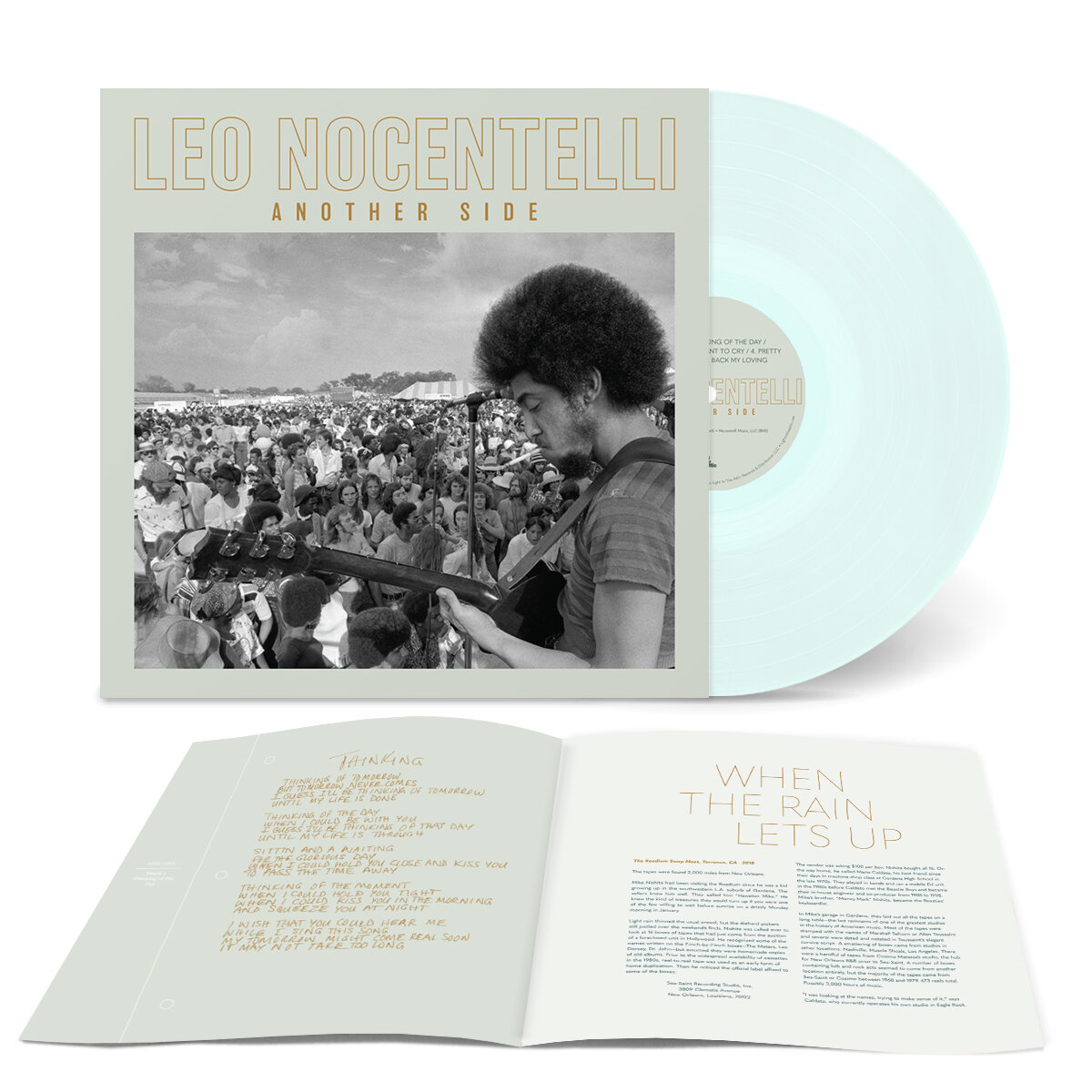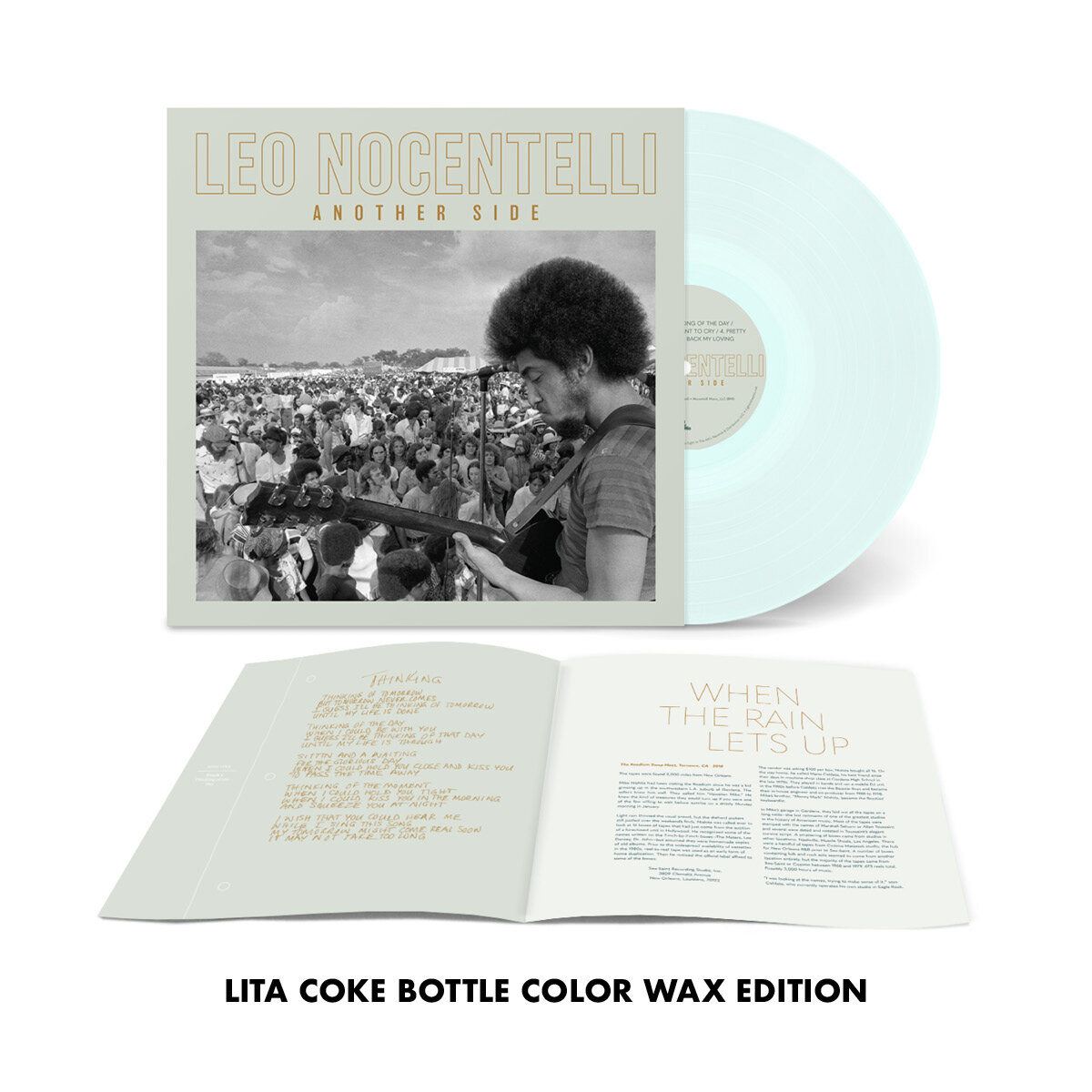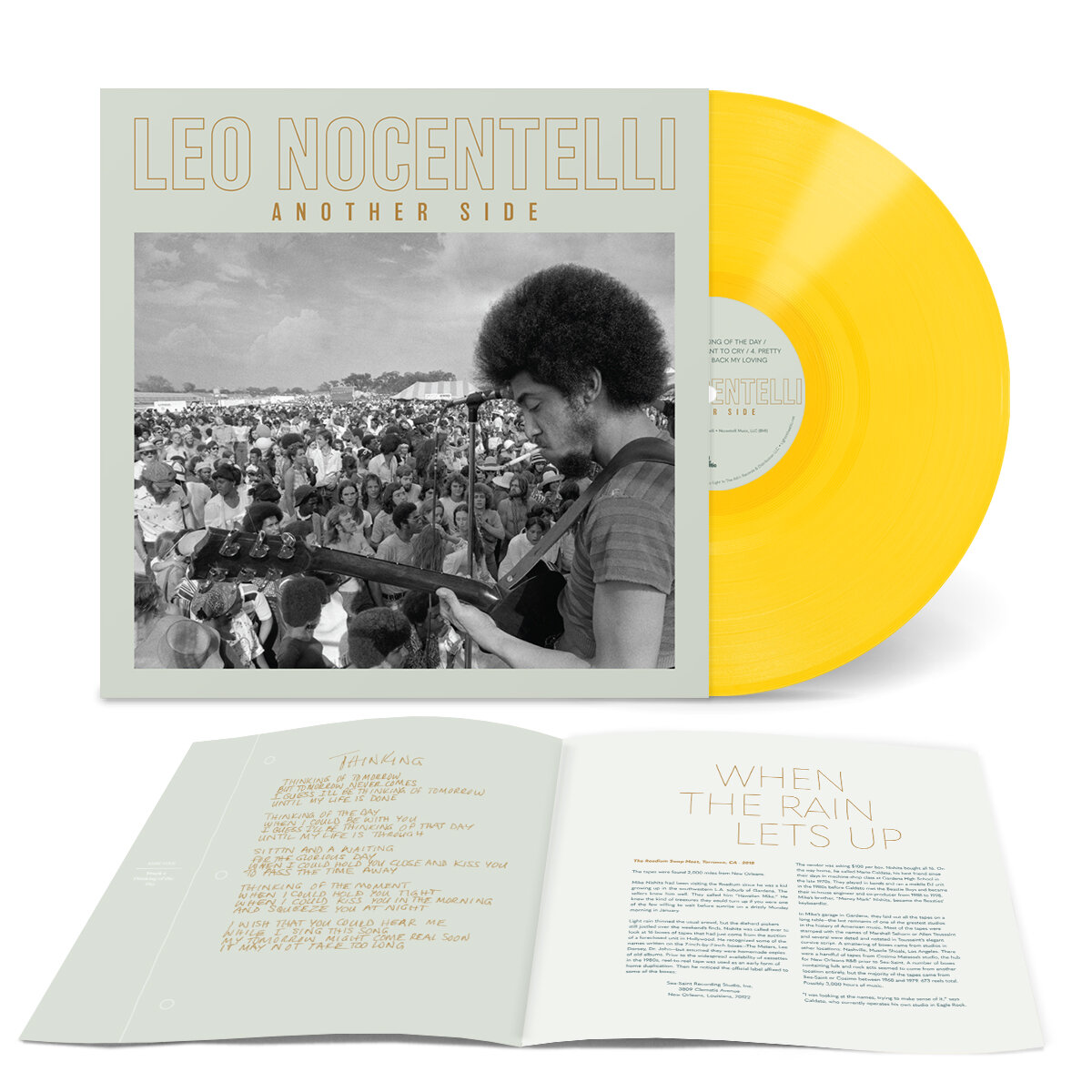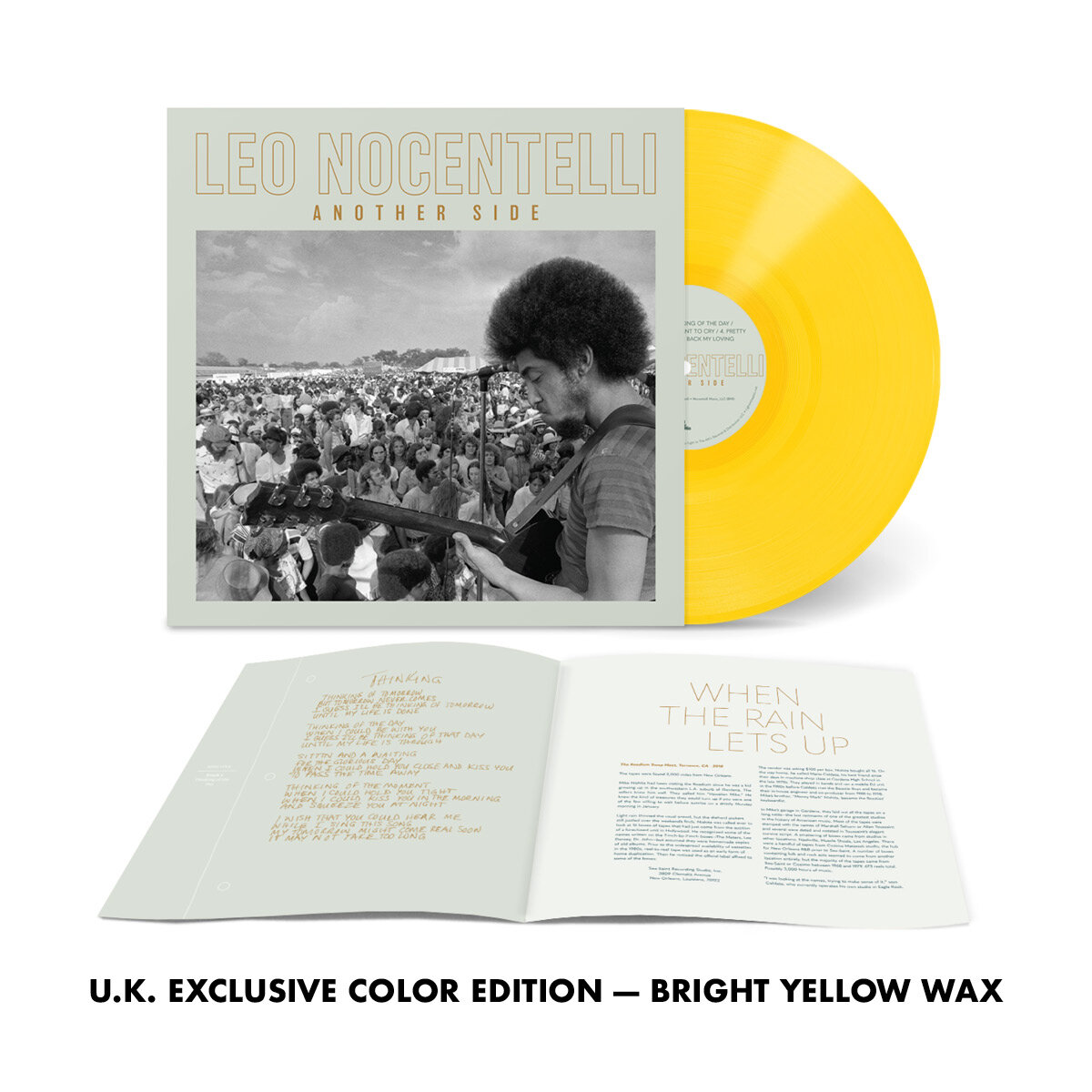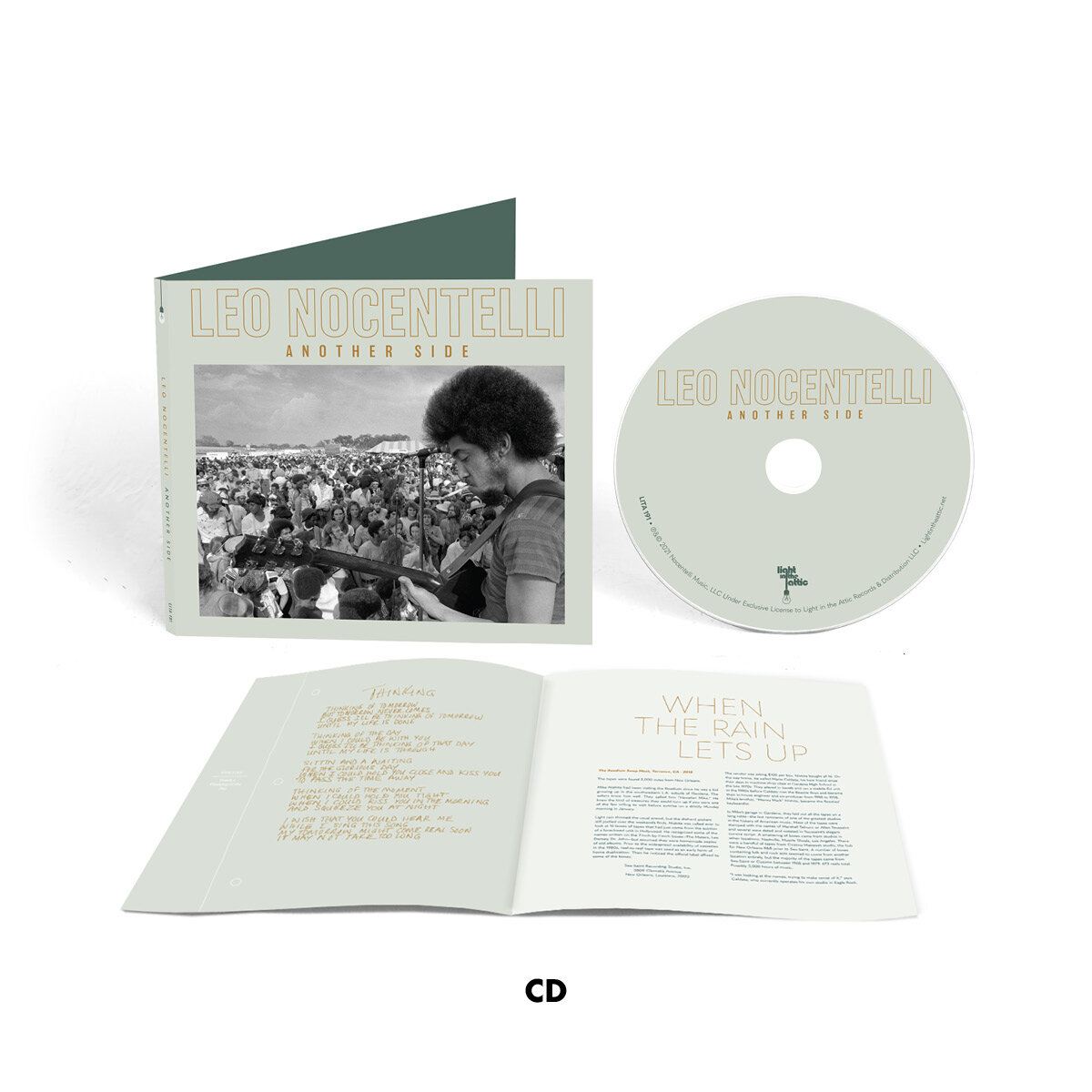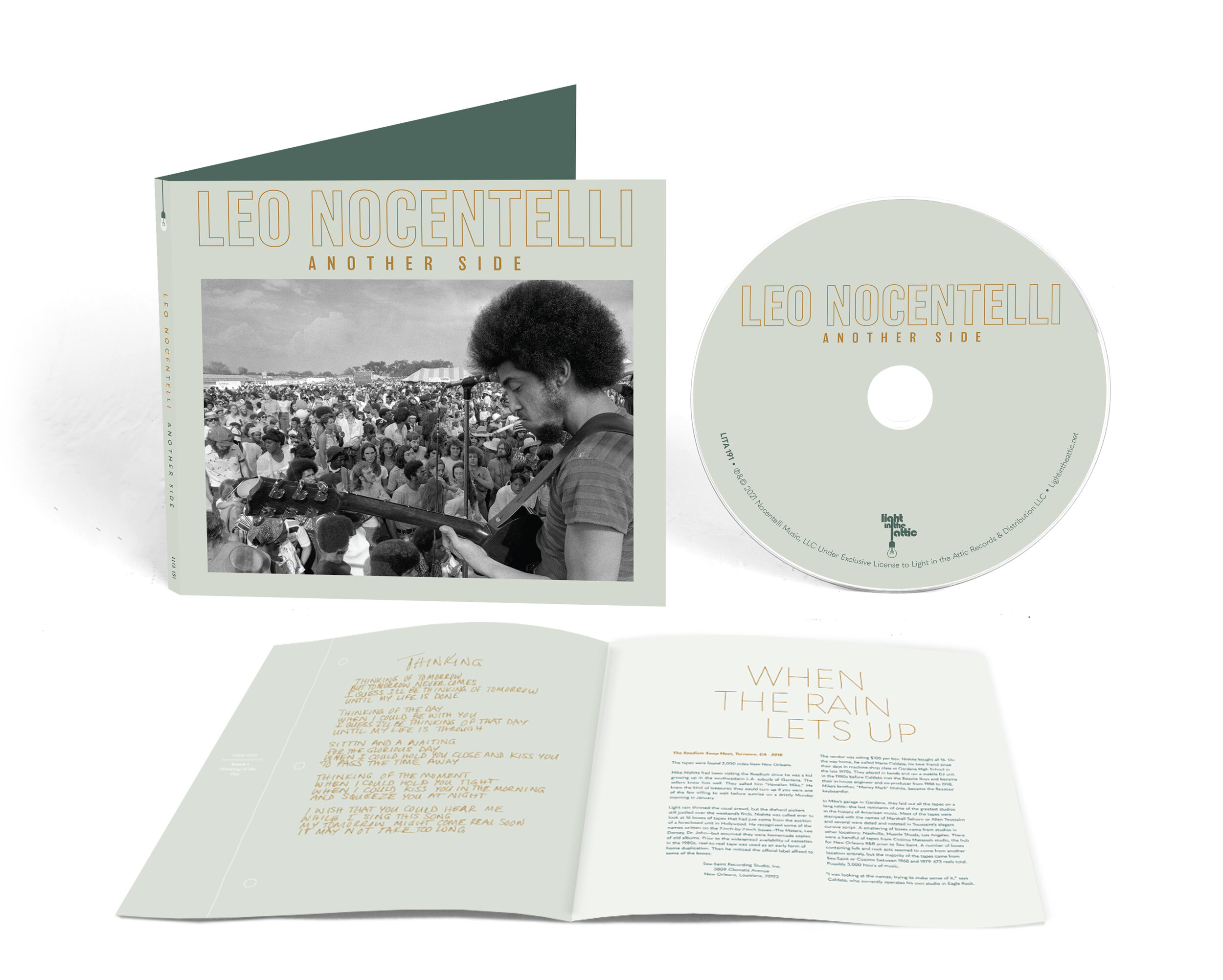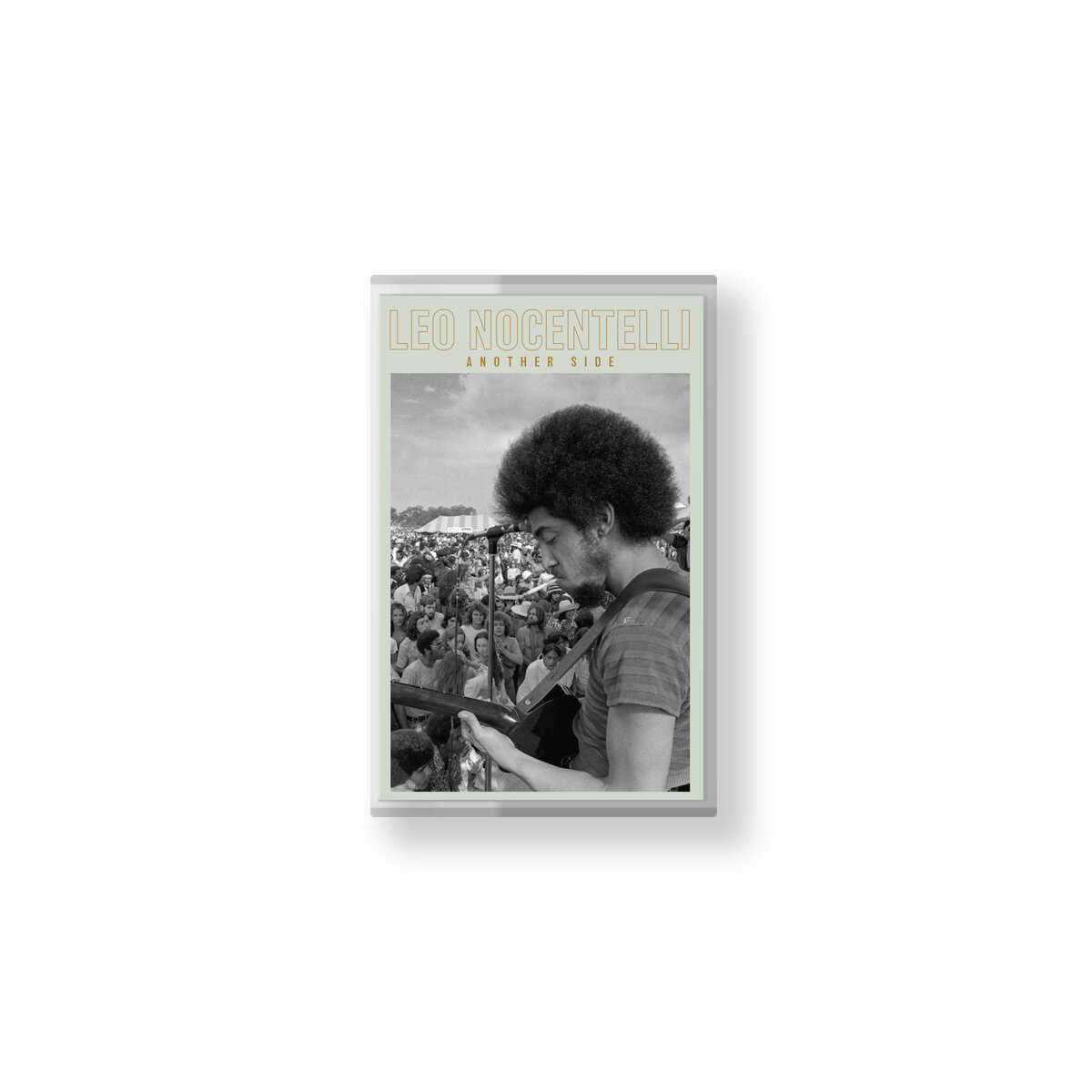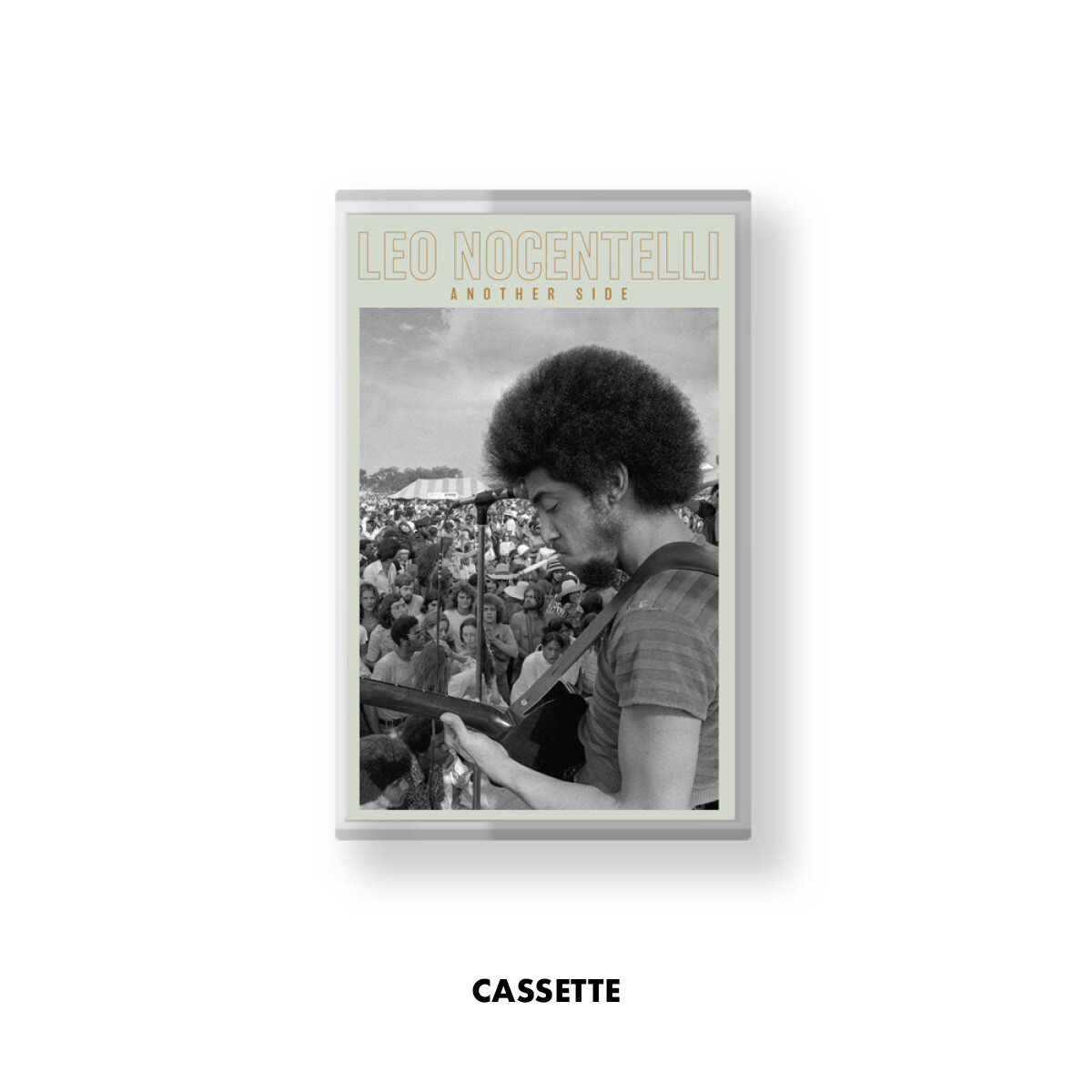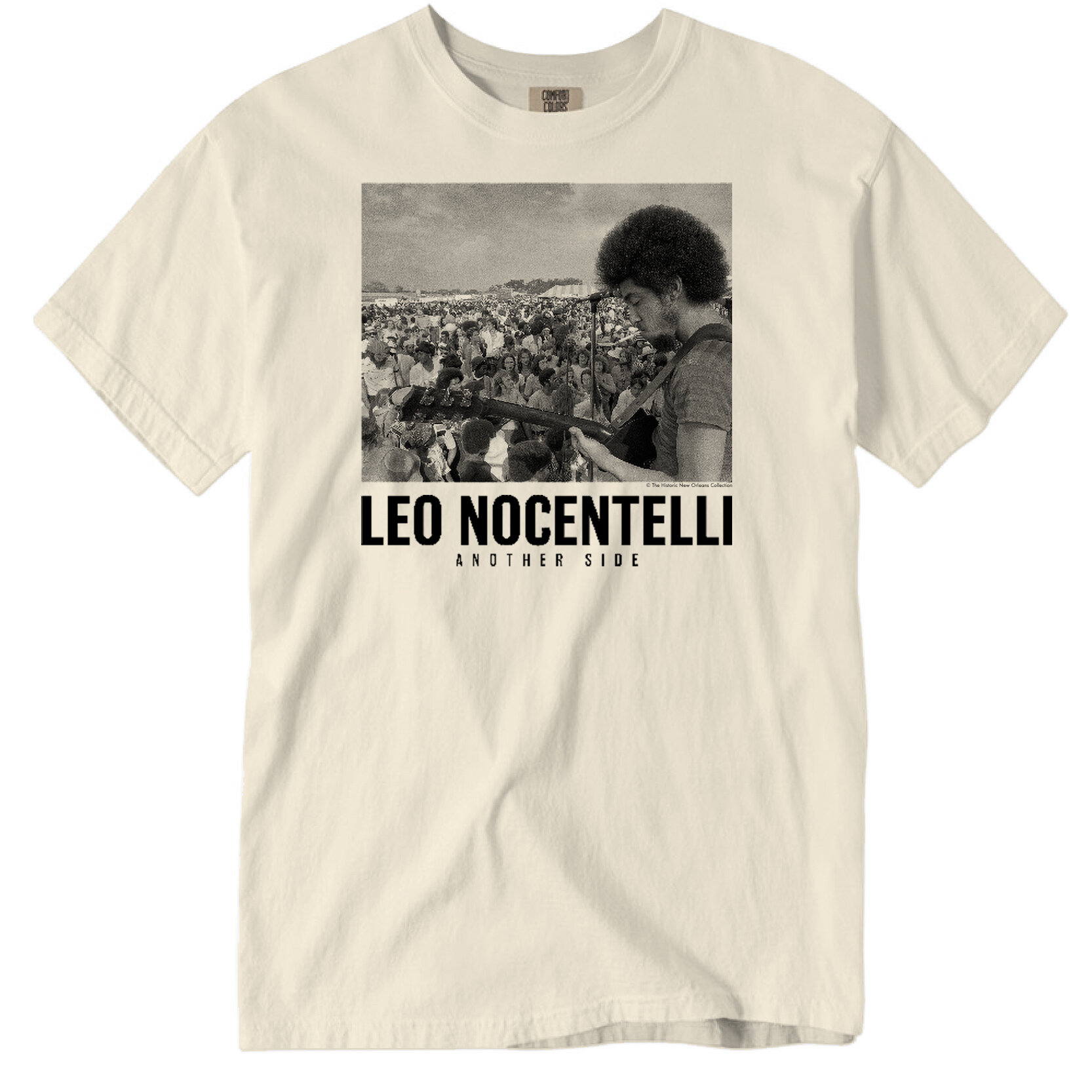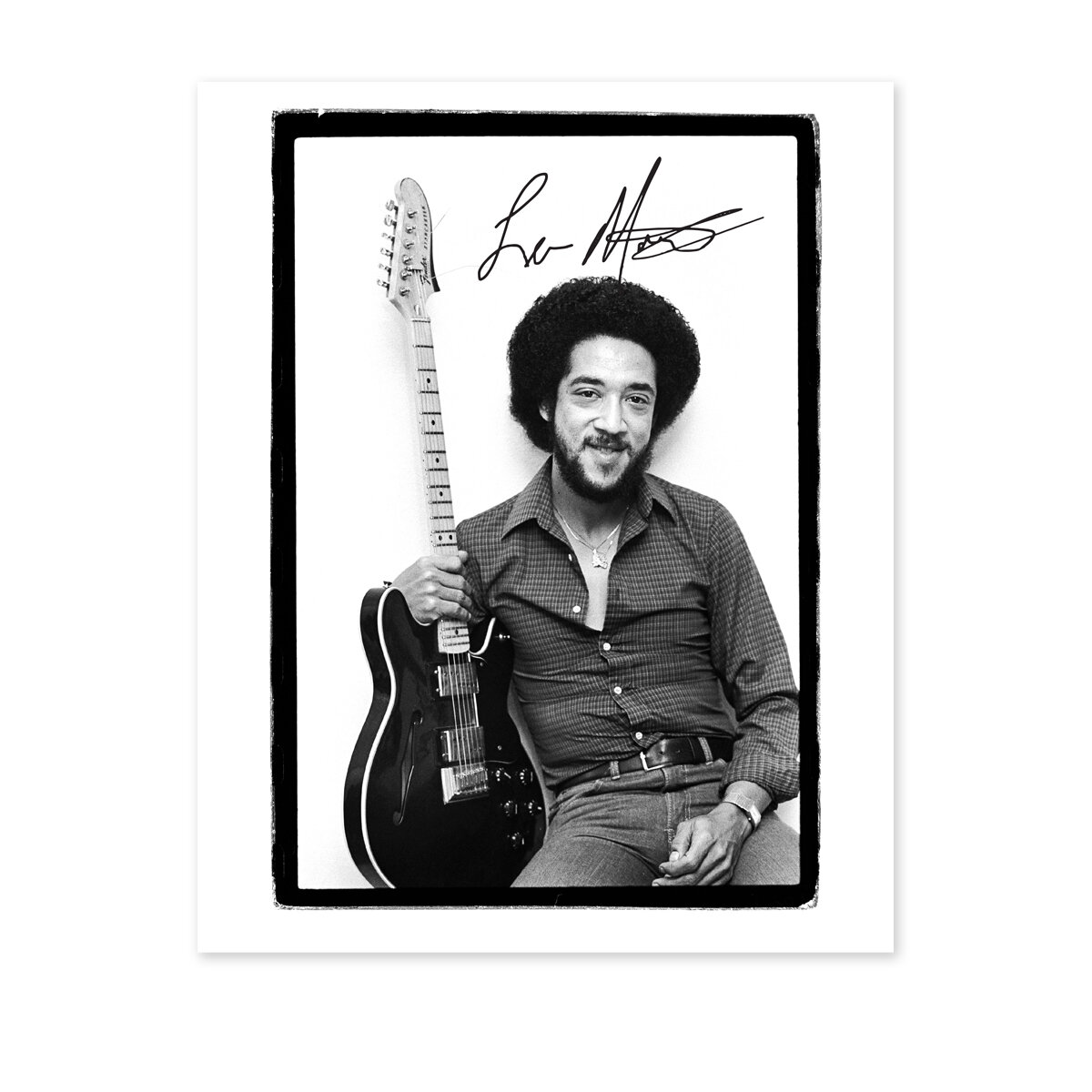Leo Nocentelli's 'Another Side' (out November 19th from Light In The Attic)
Another Side, a never-before-heard album recorded in the early ‘70s, showcases the artist’s contemplative, largely acoustic side, and features an all-star band of New Orleans royalty including:
Allen Toussaint, George Porter Jr., Zigaboo Modeliste, and James Black
Due out November 19th in vinyl, CD, cassette, and digital formats
Pre-order beginning today (9/28)
First single “Thinking Of The Day” out today on all digital platforms
cover art (photo by Michael P. Smith, © The Historic New Orleans Collection)
Click here to watch album trailer
Click here to stream/download single “Thinking Of The Day”
Click here to pre-order Another Side
Click here to download images
“What you’re telling me is an amazing discovery. That’s a part of my life that I thought was gone forever.”
- Leo Nocentelli
Los Angeles, CA (September 28, 2021)─Celebrated archival reissue label Light in the Attic (LITA) is proud to announce the release of Another Side, a previously-unreleased, early ‘70s studio album by Leo Nocentelli of the pioneering New Orleans funk outfit, The Meters. Available to pre-order beginning today (9/28) and due out on November 19th in vinyl, CD, cassette, and digital formats, the recently-unearthed album showcases a largely acoustic, more contemplative side of the legendary guitarist, who is best known for his hard-edged funk licks. Backing Nocentelli is an all-star line-up of New Orleans royalty, including Allen Toussaint (piano), James Black (drums), and both George Porter Jr. (bass) and Zigaboo Modeliste (drums) of The Meters.
In conjunction with today’s announcement, the first single “Thinking Of The Day” was released and is available now to stream/download on all digital platforms. Plus, click here to watch LITA’s just-released album trailer for Another Side.
Recorded at Cosimo Matassa’s Jazz City Studio in New Orleans between 1970-72, Another Side finds a young Nocentelli channeling his contemporaries in the burgeoning singer-songwriter movement (think Bill Withers, James Taylor, and Toussaint meeting up at Link Wray’s 3-Track Shack). Deeply introspective, the warm and funky folk album features nine original songs by Nocentelli, plus a soulful rendition of Elton John’s “Your Song,” which had recently hit the American airwaves. Half a century later, these recordings sound just as fresh and engaging as the day they were recorded.
What makes Another Side even more extraordinary, however, is the fact that the album—which could have easily become a classic in the ‘70s singer-songwriter canon—sat untouched for decades; miraculously surviving the devastating blow of Hurricane Katrina, only to be found 2,000 miles away at a Southern California swap meet in 2018 by record collector Mike Nishita.
The album’s incredible journey is documented in the liner notes by Sam Sweet (New York Times, Los Angeles Times), who spoke with Nocentelli and Nishita about the recording process and re-discovery of the tapes. Sweet’s full notes appear in the release’s accompanying booklet, alongside hand-written lyrics by Nocentelli. The first pressing of the vinyl edition will feature gold-foil treatment on cover and spine. Rounding out the package are original designs and layout by the multi-GRAMMY®-winning designer Masaki Koike. All vinyl configurations were pressed at Record Technology, Inc. (RTI). In addition to standard black wax, unique color variants will be available exclusively at LightInTheAttic.net, including the album pressed on coke bottle clear wax, along with a limited-edition deluxe edition bundle, which will include the album pressed on gold metallic wax, a limited-edition hand-numbered 8x10 archival photo by photographer Rick Olivier and signed by Nocentelli, and a new t-shirt featuring a photo of Nocentelli performing with The Meters at Jazz Fest from photographer Michael P. Smith (courtesy of The Historic New Orleans Collection). Additional vinyl color editions will be available for U.K. retailers (bright yellow) and at Vinyl Me, Please (clear, black, and gold hi-melt). All vinyl editions include a 20-page booklet, while the CD includes a 28-page booklet.
While Nocentelli was embedded in New Orleans’ R&B scene, he was also deeply inspired by the late 1960’s and early 1970’s rising singer-songwriters, and soon found himself exploring sounds that were miles away from his band’s hard-edged funk riffs. Whenever he had downtime from session work and shows, Nocentelli spent much of 1971 recording his newly-found, reflective, diaristic songs at Matassa’s Jazz City studio. Backed by longtime Meters bandmate George Porter Jr. on bass, Nocentelli crafted the lineups for his sessions to match the tone of the material. When he needed a pianist, he’d call Toussaint. For percussion on the slower songs, he used drummer Zigaboo Modeliste, but many of the tracks featured James Black—a frequent collaborator of Toussaint’s and a member of Ellis Marsalis’ jazz group, whom Nocentelli recalls as an “unbelievable” musician.
The recording, which Nocentelli fondly refers to as his “country-and-western-album,” paints a picture of a young man yearning to find a sense of purpose. “I was going through some changes which were reflected in the songs that I wrote during that time,” he tells Sweet. Among them is the mid-tempo “Getting Nowhere,” in which he expresses a sense of frustration, as he watches others find success around him. Similarly, “Till I Get There” details a man who is struggling to persevere in his goals. In the soaring “Tell Me Why,” meanwhile, the singer contemplates the existence of God.
Other songs center around fictional characters. “Pretty Mittie,” for instance, is sung from the perspective of a farmer who longs to give up his arduous life for the city. “You’ve Become a Habit” is about a man who falls for a sex worker named Fancy. “Riverfront” is based on stories that singer Aaron Neville shared, about his days working on the New Orleans waterfront. Nocentelli also chose to perform one cover: Elton John’s breakthrough hit, “Your Song.” The guitarist made the recently-released ballad his own—infusing it with a loping, head-nodding cadence, ever so tastefully “funkdafied” in true New Orleans fashion.
By the time that the album was finished, The Meters were busier than ever. They had just signed a record deal with Warner Brothers and were now the official house band at Toussaint’s studio, Sea-Saint. There, they not only backed artists on Toussaint’s Sehorn label but had also become the go-to session musicians for every major artist that recorded in New Orleans. Rather than focus on a solo career, Nocentelli poured his energies into The Meters’ next album. Eventually, time moved on, as did Nocentelli, and he decided to store his unreleased solo album at Sea-Saint for safekeeping.
In 2005, when Hurricane Katrina devastated New Orleans, Sea-Saint was among its victims. While Toussaint (who passed away in 2015) had sold the hallowed studio in the mid-90s, hundreds of his archived recordings remained in the building. The new owner salvaged what he could from the flooded building, shipping everything to a storage facility in Southern California. Boxes of tapes sat there for more than a decade before moving to another unit, which foreclosed a year later. The contents were purchased in a blind auction and, days later, sold at a swap meet. The fact that record collector Mike Nishita just happened to be there was pure kismet.
Nishita, a DJ and brother to “Money Mark” Nishita (of Beastie Boys fame), recognized the Sea-Saint label on the boxes and purchased all 673 master tapes at the swap meet. He inspected the contents with his friend Mario Caldato Jr., the longtime audio engineer for the Beastie Boys. In addition to masters from Irma Thomas, Dr. John, Lee Dorsey, and Toussaint, there was a quarter-inch reel with Nocentelli’s name on it. As Caldato and Nishita played it back, they knew they had something special.
“There was nothing else like it,” writes Sweet. “An acoustic album by the greatest funk guitarist who ever lived. It was the tape Mike would play for people to show them how special the collection was. The best album in the vault was something nobody knew existed.”
Eventually, Nishita and Nocentelli connected, “He was so grateful, so sincere,” recalls Nishita. “I just kept thinking about how this music needs to be heard...Especially when you look at all the things that had to fall into place for these tapes to survive and be discovered this way.” As Nocentelli simply puts it, “Things happen for a reason, man.”
And now, Light in the Attic is thrilled to give this remarkable record the spotlight it so rightly deserves. 50 years later, all is not lost.
More about Leo Nocentelli:
Long before he was considered to be among the world’s greatest guitarists, Rock & Roll Hall of Fame inductee and GRAMMY® Lifetime Achievement Award winner Leo Nocentelli was a busy session musician, who had been working since his early teens—backing up Otis Redding and playing on hits for the Supremes, Lee Dorsey and the Temptations. In the mid-60s, the New Orleans native co-founded The Meters, the highly influential originators of funk music. Over the next decade, the group became one of the most in-demand backing bands—performing on records for Dr. John, LaBelle and Paul McCartney, among many others, and sharing the stage with the Rolling Stones. A generation later, The Meters’ tight riffs would be sampled by countless hip-hop acts, including A Tribe Called Quest, N.W.A., 2Pac, and Public Enemy. At the turn of the ‘70s, however, The Meters were enjoying their first big breaks on Billboard’s R&B chart: 1969’s “Look-Ka Py Py” and the now-iconic “Cissy Strut”—a Nocentelli original which landed in the Top 5 and, years later, was inducted into the GRAMMY® Hall of Fame. Leo Nocentelli currently still makes music and resides in New Orleans.
Tracklist - Another Side:
Side A
1. Thinking Of The Day
2. Riverfront
3. I Want To Cry
4. Pretty Mittie
5. Give Me Back My Loving
Side B
1. Getting Nowhere
2. Till I Get There
3. You’ve Become A Habit
4. Tell Me Why
5. Your Song
All tracks are previously unreleased and never-before-heard in any format.
About Light in the Attic:
Known for their grassroots success with Rodriguez, the reclusive singer-songwriter whose unlikely story of personal triumph received long-overdue worldwide acclaim in the Academy Award®-winning documentary SEARCHING FOR SUGAR MAN, Light in the Attic has gone on to garner nominations for multiple GRAMMY® awards, including Best Historical Album for Native North America (Vol. 1) in 2015 and Kankyō Ongaku: Japanese Ambient, Environmental & New Age Music 1980-1990 in 2020. Their exuberance and dedication to spreading joy through music has propelled them through the release of 200+ titles worldwide, setting the pace for reissue labels and the archival process. From Nancy Sinatra to Donnie & Joe Emerson, Betty Davis to Haruomi Hosono, Karen Dalton to Serge Gainsbourg, the list goes on and on.
Light in the Attic is co-owned and operated by co-founders and high school friends Matt Sullivan and Josh Wright. In addition to the label’s acclaimed output, the company also distributes for nearly 150 record labels. In 2010, LITA expanded from their native Seattle by opening offices in Los Angeles, including a successful music house focused on licensing for film, television, and advertisements, along with music supervision. Light in the Attic also operates a thriving physical brick and mortar record store in the KEXP Gathering Space in Seattle. For more info, visit LightInTheAttic.net and follow on Facebook, Twitter, and Instagram.
###


